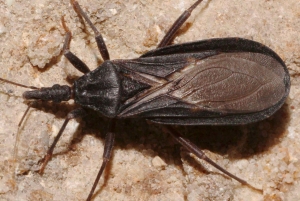Kissing bugs
These pests are outside the authority of the Vector Control Program. We offer educational information but do not control or regulate these pests.
About

Kissing bugs are bloodsucking pests that prey on different wild animals and humans. The bug's body is about the size of a penny, dark brown to black, and can have a small tan-edged abdomen.
Kissing bugs normally bite at night while their prey is asleep. The bites appear as one or a few about 1/4" apart in a line. They are usually painless but may swell and itch for a couple of days. Half of the people who are bitten may have a bad reaction the second time. Kissing bug bites are often confused with spider and tick bites.
Chagas disease
Chagas disease is not known to have been locally acquired in San Diego County. It is thought that the types of kissing bugs in San Diego County do not transmit Chagas disease very well. However, Chagas is common in Latin America, where it is spread by types of kissing bugs not found in the county.
Chagas is spread by kissing bug droppings, not by their bite. Droppings can enter the body through broken skin or the eyes. Always clean bites with iodine to avoid infection and wash to remove the droppings.
Symptoms of Chagas are usually mild or not there at all but can include fever, fatigue, body aches, headache, rash, loss of appetite, diarrhea, vomiting, and/or eyelid swelling. Chronic infection can cause severe health problems. Contact your doctor if you develop symptoms or have any concerns after a bite.
Prevention
You can prevent kissing bug problems indoors by following these tips:
- Use weather stripping and caulking to close cracks and crevices.
- Seal openings where bugs can get in.
- Fix structural problems that allow entry.
- Screen all windows and vents.
- Insect-proof pet entryways.
- Keep lights off at night by doors, windows and on patios when not needed.
- Remove rodent nests that are close to your home.
- Remove firewood piles and debris.
- Check beds at night and shake out bedding.
- Keep beds a few inches away from the wall.
Control
Chemical treatment should be a last resort. Remove hiding places and seal openings before the use of chemicals. Make sure to follow the directions on the label when using any pesticide.
More Information
Chagas
Disease - County of San Diego Health and Human Services
Agency
Kissing
Bugs and Chagas Disease - California Department of Public
Health
Chagas Disease
- CDC
Kissing Bug photo by Lon & Queta




